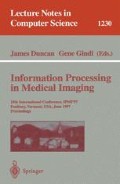Abstract
A new approach to the problem of automatic construction of eigenshape models is presented. Eigenshape models have proved to be successful in a variety of medical image analysis problems. However, automatic model construction is a difficult problem, and in many applications the models are built by hand — a painstaking process. Previous attempts to produce models automatically have been applicable only in specific cases or under certain assumptions. We show that the problem can be understood very simply in terms of shape symmetries. The pose and parameterisation of each shape must be chosen so as to produce a model that is compact and specific. We define an objective function that measures these properties. The problem of automatic model construction is thus reduced to an optimisation problem. We show that the objective function we define can be optimised by a Genetic Algorithm, and produces models that are better than hand built ones.
Preview
Unable to display preview. Download preview PDF.
References
A. Baumberg and D. Hogg. Learning flexible models from image sequences. In 3nd European Conference on Computer Vision, pages 299–308, Stockholm, 1994.
A. Baumberg and D. Hogg. An adaptive eigenshape model. In D. Pycock, editor, 6th British Machine Vison Conference, pages 87–96. BMVA Press, Sept. 1995.
I. Cohen, N. Ayache, and P. Sulger. Tracking points on deformable objects using curvature information. In G. Sandini, editor, 2nd European Conference on Computer Vision, pages 458–466. Springer-Verlag, May 1992.
T. F. Cootes, A. Hill, and C. J. Taylor. Rapid and more accurate medical image interpretation using active shape models. In 14th Conference on Information Processing in Medical Imaging, pages (371–372), France, June 1995.
T. F. Cootes, A. Hill, C. J. Taylor, and J. Haslam. The use of active shape models for locating structures in medical images. In H. H. Barrett and A. F. Gmitro, editors, 13th Conference on Information Processing in Medical Imaging, pages 33–47, Flagstaff, Arizona, USA, June 1993. Springer-Verlag.
T. F. Cootes, C. J. Taylor, D. H. Cooper, and J. Graham. Active shape models — their training and application. Computer Vision and Image Understanding, 61(1):38–59, Jan. 1995.
L. Davis. Genetic Algorithms and Simulated Annealing. Pitman, 1987.
K. Delibasis and P. E. Undrill. Anatomical object recognition using deformable geometric models. Image and Vision Computing, 12(7):423–433, Sept. 1994.
J. Duncan, R. L. Owen, L. H. Staib, and P. Anandan. Measurement of non-rigid motion using contour shape descriptors. In IEEE Conference on Computer Vision and Pattern Recognition, pages 318–324, 1991.
D. E. Goldberg. Genetic Algorithms in Search, Optimisation and Machine Learning. Addison-Wesley, 1989.
C. Goodall. Procrustes methods in the statistical analysis of shape. Journal of the Royal Statistical Society B, 53(2):285–339, 1991.
A. Hill, T. F. Cootes, C. J. Taylor, and K. Lindley. Medical image interpretation: A generic approach using deformable templates. Journal of Medical Informatics, 19(1):47–59, 1994.
A. Hill and C. J. Taylor. Automatic landmark generation for point distribution models. In E. Hancock, editor, 5th British Machine Vison Conference, pages 429–438. BMVA Press, Sept. 1994.
A. Hill and C. J. Taylor. A framework for automatic landmark identification using a new method of non-rigid correspondence. IEEE Transactions on Pattern Analysis and Machine Intelligence, page (submitted to), 1996.
A. Hill and C. J. Taylor. A method of non-rigid correspondence for automatic landmark identification. In 7th British Machine Vison Conference, pages 323–332. BMVA Press, Sept. 1996.
C. Kambhamettu and D. B. Goldgof. Point correspondence recovery in non-rigid motion. In IEEE Conference on Computer Vision and Pattern Recognition, pages 222–227, 1992.
K. V. Mardia, J. T. Kent, and A. N. Walder. Statistical shape models in image analysis. In 23rd Symposium on the Interface, pages 259–268. IEEE, Computer Society Press, 1995.
A. P. Pentland. Automatic extraction of deformable part models. International Journal of Computer Vision, 4(2):107–126, 1990.
S. Sclaroff and A. Pentland. A modal framework for correspondence and description. In 4th International Conference on Computer Vision, pages 308–313, Berlin, May 1993. IEEE Computer Society Press.
G. L. Scott and H. C. Longuet-Higgins. An algorithm for associating the features of two images. Proceedings of the Royal Statistical Society of London, 244:21–26, 1991.
L. S. Shapiro and J. M. Brady. A modal approach to feature-based correspondence. In P. Mowforth, editor, 2nd British Machine Vison Conference, pages 78–85. Springer-Verlag, Sept. 1991.
H. D. Tagare, D. O'Shea, and A. Rangarajan. A geometric criterion for shape-based non-rigid correspondence. In 5th International Conference on Computer Vision, pages 434–439, June 1995.
Author information
Authors and Affiliations
Editor information
Rights and permissions
Copyright information
© 1997 Springer-Verlag Berlin Heidelberg
About this paper
Cite this paper
Kotcheff, A.C.W., Taylor, C.J. (1997). Automatic construction of eigenshape models by Genetic Algorithm. In: Duncan, J., Gindi, G. (eds) Information Processing in Medical Imaging. IPMI 1997. Lecture Notes in Computer Science, vol 1230. Springer, Berlin, Heidelberg. https://doi.org/10.1007/3-540-63046-5_1
Download citation
DOI: https://doi.org/10.1007/3-540-63046-5_1
Published:
Publisher Name: Springer, Berlin, Heidelberg
Print ISBN: 978-3-540-63046-3
Online ISBN: 978-3-540-69070-2
eBook Packages: Springer Book Archive

